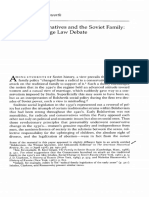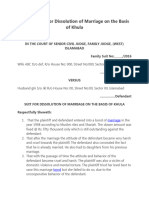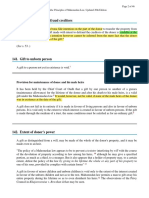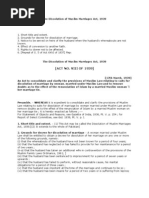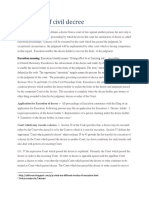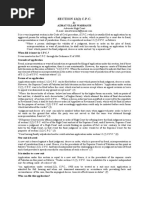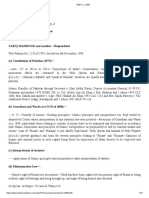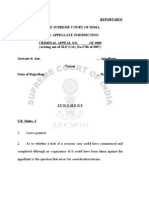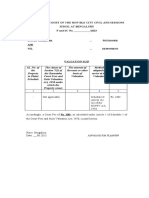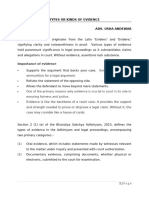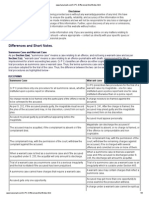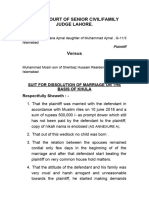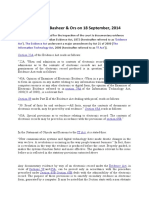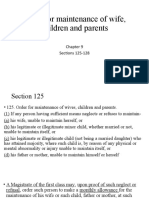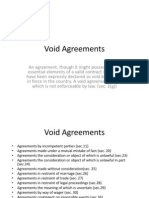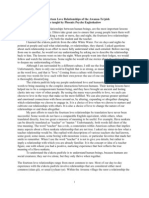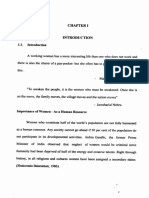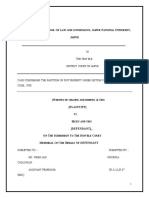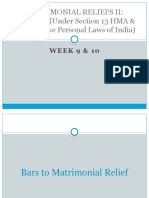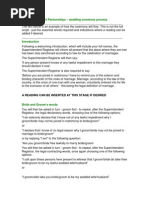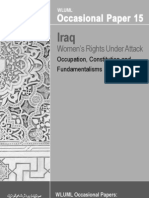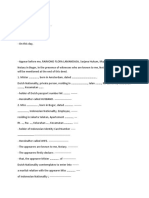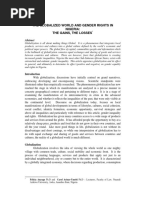Khula
Khula
Uploaded by
sameer huilgolCopyright:
Available Formats
Khula
Khula
Uploaded by
sameer huilgolOriginal Description:
Original Title
Copyright
Available Formats
Share this document
Did you find this document useful?
Is this content inappropriate?
Copyright:
Available Formats
Khula
Khula
Uploaded by
sameer huilgolCopyright:
Available Formats
From Faskh to Khula: Transformation of Muslim Women’s Right to Divorce in Pakistan
(1947-2017)
Muhammad Zubair Abbasi
Zubair.abbasi@lums.edu.pk
Assistant Professor
Lahore University of Management Sciences (LUMS)
Abstract
Based on the analysis of reported judgments spreading over 70 years (1947 - 2017), I argue that
the judges of the superior courts of Pakistan have gradually transformed women’s right to
divorce from a fault-based divorce (faskh) to no-fault based divorce (khula). By creatively
interpreting the primary sources of Islamic law (the Qur’an and Sunnah), the judges removed the
requirement of the consent of a husband for a no-fault based judicial divorce (khula), initiated by
a wife. As a result, khula (no-fault based judicial divorce) has replaced faskh (fault-based judicial
divorce) as the primary mode for the dissolution of marriage. The judges have also developed
new legal principles to protect the financial rights of divorced women. This is done by taking
into account the reciprocal benefits gained by husbands during the marriage while determining
the amount of dower that wives are required to return in consideration for khula. This
development is likely to lead to the acknowledgement of the right of divorced women to
matrimonial property.
Introduction
Under classical Islamic law (fiqh/shari‘a),1 a marriage is a privately arranged bilateral contract.
Neither its formation nor dissolution necessarily requires the intervention of a court or any other
official authority. Consequently, spouses may dissolve their marriage unilaterally or with mutual
consent with or without assigning any reason for such dissolution. In fact, a Muslim husband has
* Research for this paper was funded under the Thematic Research Grant of the Higher Education Commission of
Pakistan. I gratefully acknowledge the excellent research assistance of Muhammad Khursheed Siddiqi and thank
Asadullah Khan, Abdul Wahab Niaz, Aimen Akhtar and Shakoh Zulqarnain for editing and proofreading this paper.
I am grateful to Professor Javaid Rehman, Dr Ayesha Shahid, and Dr Shahbaz Ahmad Cheema for providing their
valuable comments on the draft article.
1
In this paper, I use the term classical Islamic law (fiqh/shari‘a) as distinguished from codified state law and case
law which may or may not be based on the principles of fiqh/shari‘a. In Farishta v Federation of Pakistan PLD
1980 Peshawar 47, 22-29, Chief Justice Abdul Hakeem Khan distinguished shari’a from the statutory law which
codified certain portions of Islamic family law under the Muslim Family Laws Ordinance 1961. He contended that
shari’a as divine law cannot be overruled by state legislation. Fiqh literally means understanding. It denotes the
meanings of human interpretations of sharī‘a, which is based on the Qur’an and the Sunnah of the Prophet
Muhammad (peace be upon him). Whereas sharī‘a is all encompassing covering both beliefs and legal injunctions,
fiqh is limited to human actions. ‘Ubayd Allāh ibn Masʿūd Maḥbūbī, Tawḍīḥ maʿa al-talwīḥ (al-Maṭbaʿa al-
Impīrāṭūriya 1884) 11-12. Muhammad Khalid Masud, Shatibi’s Philosophy of Islamic Law (Islamic Research
Institute Islamabad 1995) 18-20. For details see Shaheen Sardar Ali, Modern Challenges to Islamic Law (Cambridge
University Press 2016) 22-29.
Electronic copy available at: https://ssrn.com/abstract=3307766
an absolute and unilateral right to a no-fault dissolution of marriage by pronouncing the word
‘talaq’ thrice at once or at different points in time. Unlike her husband, a Muslim wife does not
have such unilateral right. Her no-fault based right to dissolution of marriage (khula) is limited
because it is based on her claim of irretrievable breakdown of marriage and requires the consent
of her husband.2 Moreover, unlike her husband who does not need to go to a court to dissolve the
marriage, she must resort to a court to have her marriage dissolved based on a valid reason
through a judicial decree (faskh—fault-based divorce). Because of this gender disparity, only
Muslim wives and not their husbands, file suits for dissolution of marriage before courts.
Although marriage under Islamic law is a contract, yet according to classical Muslim
jurists, a husband has ownership (authority or dominion) in a marriage contract (milk al-nikah).3
Therefore, he has unilateral control over the termination of the legal relationship of marriage. He
may delegate this right to repudiation to his wife, or she may get his consent for divorce after
compensating him by the return of the dower that she received at the time of marriage (khula). In
cases where this right has not been delegated to the wife or the husband has refused to accept
compensation for divorce, the wife has the right to a fault-based judicial divorce if she proves
cruelty, impotency, desertion, or non-maintenance by her husband. While a wife requires the
consent of the husband if she wishes to repudiate her marriage contract, her consent is not
required when a husband exercises his right to repudiation (talaq).4 In fact, her consent is not
required even when her husband revokes his single or double pronouncement of talaq during the
waiting period (iddat). In jurisprudential discourse, this general description of classical Islamic
law of marriage and divorce has led to the assimilation of marriage with slavery.5 The superiority
of a husband in the institution of marriage is manifested in his unilateral right to repudiation
(talaq). Even though a wife is not denied the right to divorce, her right depends upon the consent
of her husband. Such imbalance of rights to divorce is in stark contrast to the notion of gender
equality.
This relatively weaker status of a Muslim wife’s right to dissolution of marriage under
Islamic law has led to various legislative and judicial reforms in the Muslim world.6 Based on
the analysis of the reported judgments of Pakistani superior courts (High Courts, Federal Shariat
Court, and Supreme Court) from 1947 to 2017, I argue that in Pakistan, a Muslim woman’s right
2
For details see Dinshah Fardunji Mulla, Principles of Mahomedan Law (20th edn, LexisNexis, 2013) 389-419; Faiz
Badrudin Tyabji, Muhammadan Law (3rd edn, N. M. Tripathi 1940) 204-52; and Asif Ali Asghar Fyzee, Outlines of
Muhammadan Law (5th edn, Oxford University Press 2008) 117-51.
3
In al-Fatawa al-Alamgiriyya, marriage (nikah) is defined as a contract which is intended for the enjoyment of
proprietary rights ‘milk al-mut‘at’. Shaikh Nizam, al-Fatawa al-Alamgiriyya (Qadimi Book Khana, nd) 295.
4
The wife has a right to repudiate her marriage without the consent of her husband in case she was given in
marriage by her guardian (wali) when she was a minor. She can exercise this right upon attaining the age of majority
(khiyar al-bulugh). The exercise of this right does not depend upon the consent of the husband. There is a difference
of juristic opinions whether a decree of the court is required for the dissolution of marriage based on the exercise of
this right.
5
Kecia Ali, Marriage and Slavery in Early Islam (Harvard University Press 2010) 113-63.
6
Mulki Al-Sharmani, Gender Justice and Legal Reform in Egypt: Negotiating Muslim Family Law (American
University Press in Cairo 2018); Nadia Sonneveld, Khul‘ Divorce in Egypt: Public Debates, Judicial Practices, and
Everyday Life (American University in Cairo Press 2012); Lynn Welchman, Women and Muslim Family Laws in
Arab States (Amsterdam University Press 2007); James Norman Dalrymple Anderson, Reforms in the Law of
Divorce in the Muslim World (1970) 31 Studia Islamica 41.
Electronic copy available at: https://ssrn.com/abstract=3307766
to dissolution of marriage has become virtually equal to a similar right of her husband, though
unlike the latter she has to make a recourse to a court to exercise it if her husband does not
concede to her demand for dissolution of marriage.7 Given the high success rate of dissolution of
marriage petitions, the procedural obstacle regarding the women’s right to dissolution of
marriage seems to have become merely a formality. In practice, a Muslim woman’s right to
dissolution of marriage has become functionally equivalent to that of a man.8
This paper is divided into three parts. Part I provides an overview of Islamic law of
divorce in Pakistan. Part II is based on a quantitative analysis of reported judgments on
dissolution of marriage from 1947 to 2017. Part III contains a qualitative analysis of these
judgments. In conclusion, it is pointed out that in Pakistan women’s right to dissolution of
marriage has been transformed from a fault-based divorce (faskh) to no-fault based divorce
(khula) and the focus of recent judgments has been on the financial rights of divorced women.
The courts take into account ‘reciprocal benefits’ acquired by husbands during the subsistence of
marriage while determining the consideration for khula. This legal development may lead to the
acknowledgement of women’s right to matrimonial property which would ensure gender equality
in the institution of marriage under Islamic family law in Pakistan.
Part I. Islamic Law on Dissolution of Marriage in Pakistan
In Pakistan, Islamic divorce law is primarily based on un-codified fiqh which has been gradually
incorporated into the judicial precedents of the superior courts. These precedents have been
supplemented with two main statutes: the Dissolution of Muslim Marriages Act 1939 (DMMA);
and the Muslim Family Laws Ordinance 1961 (MFLO). Section 2 of the DMMA provides the
following grounds for dissolution of marriage:
i) Disappearance of the husband for four years;
ii) Husband’s failure to provide maintenance for two years;
iii) Husband’s final sentence to imprisonment for seven or more years;
iv) Husband’s failure to perform his marital obligations for three years;
v) Husband’s impotence at the time of marriage and its continuity;
7
This is evident from the principles laid down in various judgments: Gul Hassan v Mst. Nasreen Akhtar 2014 YLR
1743 (A marriage should be dissolved on the basis of khula when a wife is determined not to live with her husband
because of her aversion towards him, even if it is without any fault of the husband.); Abdul Rasheed v Judge Family
Court Mian Channu 2010 CLC 797 (Once a wife approaches the court for the dissolution of marriage on the basis of
khula, the court has no option but to accede to her request.); and Abdul Hameed v Mst. Rubina Bibi 2010 CLC 1681
(If the wife categorically states that she wants divorce, the court may safely presume that the spouses cannot live
together in harmony.).
8
The developments in case law led the Council of Islamic Ideology, an advisory constitutional body to the
legislature, to propose that a wife should have a right to demand a divorce from her husband by serving a notice
upon him setting out the reasons and grounds for her demand. A copy of the notice should be sent to the Chairman
Union Council. The divorce will become effective upon the expiration of ninety days if no reconciliation happens
between the spouses, or the wife does not withdraw her notice, or the husband does not respond. Council of Islamic
Ideology, Muslim ‘A’lī Qawānīn Ordinance 1961: Naẓar Thānī aur Sifārishāt (Government of Pakistan 2009) (in
Urdu). The government did not legislate upon the recommendations of the Council. Given the social and cultural
barriers in women’s access to justice through courts in Pakistan, the implementation of the Council’s
recommendations could have facilitated women to exercise their right to divorce more freely.
Electronic copy available at: https://ssrn.com/abstract=3307766
vi) Husband’s insanity for two years or suffering from leprosy or a virulent venereal disease;
vii) A wife, given in marriage by her father or other guardian before she attained the age of
sixteen years, repudiates the marriage before attaining the age of eighteen years,
provided that the marriage has not been consummated;9
viii) Li‘an: where the husband has accused his wife of zina and the wife does not accept
the accusations as true;
ix) Cruel treatment of the wife by the husband (includes mental cruelty, association with
women of ill repute or leading an infamous life, forcing a wife to live an immoral life,
interference with wife’s property, obstruction in her observance of religious
profession or practice, and failure to treat wives equitably, in case of polygamy); or
x) Any other ground recognized as valid under Muslim law.
Under the MFLO, a husband’s taking of an additional wife, without the consent of the first wife
as required under the MFLO, was added as an additional ground for the dissolution of marriage
under the DMMA.10 However, this ground was removed in 1981 under Zia ul Haq’s Islamisation
of laws.11
Under Islamic law of divorce in Pakistan, generally a marriage can be dissolved
unilaterally by the husband or the wife; or with mutual consent of the spouses; or by the court or
with the death or apostasy of either spouse.12 Talaq is the prerogative of a husband to unilaterally
terminate the contract of marriage without assigning any cause for doing so.13 He may delegate
this right to his wife or to a third party (talaq al-tafwiz). Khula is the prerogative of a wife to
terminate the contract of marriage. It functions as a single irrevocable divorce (talaq-e-bayn),
and the wife is free to remarry her ex-husband without the need for an intervening marriage
(halala). The wife’s right of khula stands on a par with the husband’s right of talaq. The two,
however, are procedurally different. For obtaining khula, the wife needs to go to a court and state
that the marriage has irretrievably broken down and thus it is impossible for her to reside with
her husband within the limits prescribed by Allah. However, in case of talaq, the husband can
proceed by himself and thus does not need to go to a court.14 Moreover, a wife can also exercise
9
Under the Child Marriage Restraint Act 1929, the marriage of children (under 18 years of age for males and under
16 years of age for females in Punjab) is a criminal offence yet the marriage is still valid.
10
Section 2 (ii-a) was inserted in the DMMA under section 13 of the MFLO 1961.
11
Section 13 of the MFLO was omitted under section 3 and Sch II of the Federal Laws (Revision and Declaration)
Ordinance 1981 (XXVII of 1981). The Peshawar High Court noted this amendment in the law and refused to accept
a husband’s second marriage as a valid ground for the dissolution of marriage in Syed Rashid Ali Shah v Mst.
Haleema Bibi PLD 2014 Peshawar 226. The Lahore High Court, however, appears to be unaware of this change in
the law and regarded a husband’s second marriage as a valid ground for the dissolution of marriage in Sajjad
Hussain alias Allah Ditta Khan v Judge Family Court, Mailsi 2015 CLC 1347.
12
Jurists hold different views regarding the effect of apostasy on the marriage of a Muslim wife. For details, see
Tanzil-ur-Rahman, A Code of Muslim Personal Law (1 of 2 vols, Islamic Publishers 1980) 653-61.
13
Cassandra Balchin, A Handbook on Family Law in Pakistan (Shirkat Gah 1994) 43.
14
The legislature in Pakistan has tried to put a check on a husband’s unfettered right to talaq. Section 7 of the
MFLO requires a husband to give a written notice of his pronouncement of talaq to the Chairman and to provide a
copy of this notice to the wife. Within thirty days of the receipt of the notice, the Chairman is required to constitute
an Arbitration Council to ‘bring about a reconciliation between the parties. Unless the husband revokes talaq, it
becomes effective after ninety days of the notice and if the wife is pregnant at the time of the notice until the end of
her pregnancy. This section has been subjected to multiple interpretations by courts over time. In Syed Ali Nawaz
Gardezi v Lt. Col. Muhammad Yusuf PLD 1963 SC 51, the SC held that the talaq is deemed to have been revoked in
Electronic copy available at: https://ssrn.com/abstract=3307766
the option of talaq al-tafwiz if her husband has delegated this right of divorce to her by including
a stipulation to this effect in the nikahnama (contract of marriage). This right may also be given
to a third party, and may be given either conditionally or absolutely, and temporarily or
permanently.15 Faskh and lian are the options that a court can exercise to terminate the contract
of marriage. In case of faskh, it is the wife who approaches the court for dissolution of marriage
under the DMMA. Mubarat is termination of the contract of marriage through the consent of
spouses. This termination may be conditional or unconditional, and the wife may or may not be
required to give up her dower or any other right to the husband in exchange as consideration for
mubarat.
Part II. Quantitative Analysis of Reported Judgments
This part provides findings from a quantitative analysis of all the reported judgments on the
dissolution of marriage in Pakistan from 1947 to 2017.16 Generally, I have divided the judgments
under two broad categories of khula and DMMA notwithstanding the fact that technically, khula
falls under section 2 (ix) of the DMMA.17 This classification is based on the grounds that the
court took into consideration to decree petitions for the dissolution of marriage. As mentioned
above, khula is a no-fault based right to dissolution of marriage while faskh (literally
cancellation) is a fault-based dissolution of marriage. It is not necessary for khula to be
adjudicated before a court of law. Only when a husband does not agree to divorce his wife upon
her demand, that she has to come to the court for a decree based on khula. From the procedural
perspective, family courts decided khula petitions summarily i.e., without recording of
evidence. 18 The dissolution of marriage under the DMMA, legally called faskh, requires
recording of evidence. In practice, in their petitions wives allege the grounds under the DMMA
and ask for the dissolution of marriage on the basis of khula as an alternative remedy in case the
court is not satisfied with their fault-based claims. Given the convenience of summary procedure
for the petitioners, lawyers, and judges, an overwhelmingly large number of the dissolution of
marriage petitions are decreed on the basis of khula unless the dower involved huge amount of
money or valuable immovable property.19 The distinction between faskh and khula is crucial
the absence of the notice under the MFLO. However, in Kaneez Fatima v Wali Muhammad PLD 1993 SC 901, the
SC revisited this principle and held that the notice requirement under the MFLO is to be taken into account on a case
by case basis. In Shoukat Ali v The State 2004 YLR 619, the FSC held that a talaq is valid despite non-fulfillment of
the notice requirement under the MFLO.
15
Muhammad Munir, ‘Stipulations in a Muslim Marriage Contract with Special Reference to Talaq Al-Tafwid
Provisions in Pakistan’ (2005-2006) 12 Yearbook of Islamic and Middle Eastern Law 235.
16
It must be noted that the number of judgments mentioned herein does not necessarily reflect the exact number of
the reported judgments. Since the aim of this paper is to identify the general trends in dissolution of marriages in
Pakistan, the focus has particularly been on those cases that have substantively contributed towards the development
of law.
17
Under this section, a Muslim woman is entitled to obtain a decree for the dissolution of marriage ‘on any other
ground which is recognized as valid for the dissolution of marriage under Muslim law’.
18
This is the case after the amendment in the Family Courts Act 1964 in 2002. The amended section 10(4) of the
Family Courts Act 1964 authorizes the Family Courts to dissolve a marriage on the basis of khula if reconciliation
between spouse fails. The Family Courts (Amendment) Ordinance 2002.
19
For instance, in Tabassum Khurshid v Sardar Abid Iqbal 2008 CLC 1337, the wife did not claim khula as an
alternative remedy because she did not want to return her dower of Rs. 10 lakhs (one million). Similarly, in
Muhammad Arif v Saima Noreen 2015 SCMR 804, the wife did not ask for khula as an alternative remedy because
her dower consisted of a valuable property and she did not want to return it as consideration for khula.
Electronic copy available at: https://ssrn.com/abstract=3307766
because of the resulting different financial consequences. Therefore, judges clearly state in their
decisions whether the marriage is dissolved on the basis of khula or any one or more grounds
provided under the DMMA.
Before proceeding further, it is important to bear in mind the limitations of the data that is
used here for the quantitative analysis. Although I have looked into a number of unreported
judgments of family courts, the analysis here is limited only to the reported judgments of the
superior courts. This means that these judgments may not reflect the actual number of petitions
of the dissolution of marriage decided by family courts because only a small number of such
decisions are challenged before the superior courts.20 Nonetheless, not only that the reported
judgments of superior courts reflect trends in the application and development of legal principles,
but they also reflect the practice of lower family courts whose decisions are subjected to judicial
scrutiny.
A total of 376 judgments of khula have been reported during the seventy years between
1947 and 2017. The number of reported judgments of khula on average has been increasing since
1947. A comparison of the number of reported judgments from 1947 to 2000 and 2001 to 2017
reveals interesting trends. For the period between 1947 and 2000, 159 judgments on khula have
been reported. In contrast, for the period between 2001 and 2017, 217 judgments on khula have
been reported. This means that during the past sixteen years, the total number of reported
judgments on khula is higher than the total number of such cases during the fifty-four years from
1947 to 2000!21
The table below shows the number of reported judgments on khula decided by various
high courts:
TABLE 1: KHULA JUDGMENTS
Jurisdiction 1947-2000 2001-2017 Total (1947-2017)
Punjab 106 111 217
Sindh 25 31 56
KPK 6 34 40
Balochistan 1 6 7
ICT 5 13 18
AJ&K 16 22 38
20
Under section 14(2)(a) of the Family Courts Act 1964, no appeal shall lie from a decree passed by a family court
for dissolution of marriage, except in the case of dissolution of marriage on the ground that the husband habitually
assaults his wife or makes her life miserable by cruelty of conduct even if such conduct does not amount to physical
ill-treatment. In practice, dissolution of marriage decrees of the family courts are challenged before the high courts
through writ petitions under the constitutional jurisdiction of such courts envisaged under Article 199 of the
Constitution of Islamic Republic of Pakistan 1973.
21
There is a significant increase even when the population growth is taken into account. For details on population
growth rate of Pakistan see http://www.pbs.gov.pk/sites/default/files/other/pocket_book2006/2.pdf (accessed 18
October 2018).
Electronic copy available at: https://ssrn.com/abstract=3307766
Total 159 217 376
In contrast with the overall increasing number of judgments on khula, the number of
judgments under the DMMA has decreased. A total of 73 judgments under the DMMA have
been reported between 1947 and 2017. Overall, 46 judgments have been reported from 1947 to
2000 and this number decreased to 27 during 2001 and 2017. The table below shows the number
of reported judgments under the DMMA decided by various high courts:
TABLE 2: DMMA JUDGMENTS
Jurisdiction 1947-2000 2001-2017 Total (1947-2017)
Punjab 24 7 31
Sindh 9 1 10
KPK 6 12 18
Balochistan 0 0 0
ICT 1 3 4
AJ&K 6 4 10
Total 46 27 73
The following table shows the overall number of reported judgments on khula and DMMA.
TABLE 3: TOTAL KHULA AND DMMA JUDGMENTS
Type 1947-2000 2001-2017 1947-2017
Khula 159 217 376
DMMA 46 27 73
Overall, between 1947 and 2017, 84% of the total reported judgments of dissolution of
marriage have been of khula, whereas the remaining 16% have been of the DMMA. Between
1947 and 2000, 78% of the total reported judgments of dissolution of marriage have been of
khula, whereas the remaining 22% have been of the DMMA. In contrast, between 2001 and
2017, 89% of the total reported cases of dissolution of marriages have been of khula, whereas the
remaining 11% have been of the DMMA. This means that post-2000 (as compared to pre-2000),
the proportion of judgments of khula has increased by 11%.
The increase in the reported judgments of khula can be attributed to various factors. One
key factor is the liberal interpretation of the law relating to khula, which has made it far easier
for women to obtain a decree of dissolution of marriage on the basis of khula. For instance, in
various judgments, the courts have held that if the marriage has irretrievably broken down or if
the wife is not willing to live with her husband, then the marriage shall be dissolved on the basis
Electronic copy available at: https://ssrn.com/abstract=3307766
of khula even if the wife did not claim it.22 Similarly, the courts have also held that if compelling
the wife to live with her husband would give rise to a hateful union, then the marriage shall be
dissolved on the basis of khula. Generally, the test for granting khula has been to satisfy the
conscience of the court that the spouses can no longer live together within the limits prescribed
by Allah.23 The courts have held that if a wife loses trust in her counterpart and there seems no
possibility of reconciliation, the marriage is liable to be dissolved on the basis of khula.24 Such a
subjective test when coupled with the liberal interpretation of the relevant law has made khula
far easier than it was before the 2002 amendment in the Family Courts Act 1964 which provided
a summary procedure for khula.25
The reported judgments under the DMMA between 1947 and 2017, can be divided into
the following six categories: 1) cruelty; 2) non-payment of maintenance allowance; 3) option of
puberty; 4) non-performance of marital obligations; 5) second marriage without consent; and 6)
impotency of husband. The cases/judgments of cruelty have been on the one end of the spectrum,
with a total of 41 reported cases/judgments; and the cases/judgments of impotency of husband
have been on the other end of the spectrum, with a total of 3 reported judgments. Between these
two extremes lie the cases/judgments of non-payment of maintenance allowance (25), option of
puberty (14), non-performance of marital obligations (6), and second marriage without the
consent of the first wife (5).26
For the period between 1947 and 2000, 20 cases of cruelty, 15 cases/judgments of non-
payment of maintenance allowance, 14 cases/judgments option of puberty, 4 cases/judgments of
non-performance of marital obligations, 3 cases/judgments of impotency of husband, and 1 case
of second marriage without the consent of the first wife have been reported. In contrast, for the
period between 2001 and 2017, 21 cases/judgments of cruelty, 10 cases/judgments of non-
payment of maintenance allowance, 2 cases/judgments of non-performance of marital
obligations, and 4 cases/judgments of second marriage without the consent of the first wife have
been reported. It is worth noting that during the period between 2001 and 2017, no judgment
involving option of puberty or impotency of husband has been reported. This means that post-
2000 (as compared to pre-2000), cases of all categories of the DMMA have decreased, with the
exception of the cases of cruelty and the second marriage without the consent of the first wife.
22
Muhammad Iqbal Kocub v Judge Family Court Lahore 1993 CLC 699; Muhammad Akram v Mst. Shakeela Bibi
2003 CLC 1787; Abdul Khaliq v Judge Family Court 2003 MLD 1120; Muhammad Ismail v Judge Family Court,
Rahim Yar Khan 2009 YLR 1700; Muhammad Arif v Saima Noreen 2015 SCMR 804.
23
Mst. Bilquis Fatima v Najm-ul-Ikram Qureshi PLD 1959 Lahore 566; Mst. Khurshid Bibi v Muhammad Amin
PLD 1967 SC 97; Mst. Rashidan Bibi v Bashir Ahmed PLD 1983 Lahore 549; Bashir Ahmad v Mst Nasreen 1991
CLC 1234; Mst. Balqees Bano v Shamim Ahmad 1991 CLC Lahore 2057.
24
Muhammad Shafique v Mst. Gul Taj PLD 2007 SC (AJ&K) 56; Saleem Ahmad v Government of Pakistan PLD
2014 FSC 43; Syed Shoukat Gillani v Mst. Ansar Gillani 2017 MLD 1677.
25
The Family Courts (Amendment) Ordinance 2002.
26
The total number of DMMA cases/judgments under various categories is higher (94 as against 73) because in
some cases the courts dissolved the marriage based on multiple grounds which fall under multiple categories. For
instance, in Muhammad Zafar v Kamal Fatima PLD 1981 Lahore 732, the family court dissolved the marriage on
the basis of desertion for more than two years and habitual cruelty of the husband. In an appeal before the High
Court, the husband contended that these two grounds are mutually destructive because he could not have been cruel
to his wife if he had already deserted her. The court, however, dismissed this argument because the evidence showed
that even after her desertion, he had beaten her outside the school where she was employed as a teacher.
Electronic copy available at: https://ssrn.com/abstract=3307766
The decrease in the cases of almost all categories of the DMMA is attributable to the
overwhelming increase in the number of cases/judgments of khula post-2000. As explained
above, this is partially because khula has become a summary remedy after the 2002 amendment
in the Family Courts Act 1964. A wife can get a decree of dissolution of marriage on the basis of
khula without following lengthy judicial procedures and recording of evidence.
TABLE 4: BREAKDOWN OF DMMA JUDGMENTS
Type 1947-2000 2001-2017 (Total 1947-2017)
Cruelty 20 21 41
Non-Payment of Maintenance Allowance 15 10 25
Option of Puberty 14 0 14
Non-Performance of Marital Obligations 4 2 6
Second Marriage without Consent 1 4 5
Impotency of Husband 3 0 3
The success rate of dissolution of marriage petitions has been very high. There were 66
successful claims as against 7 unsuccessful claims under the DMMA. This means that 91%
petitions under the DMMA were successful (66/73). For the period between 1947 and 2000, 89%
petitions under the DMMA were successful, whereas for the period between 2001 and 2017,
93% such petitions were successful. These percentages show that the success rate of the petitions
under the DMMA has generally been very high throughout from 1947 till 2017.
TABLE 5: NUMBER OF UNSUCCESSFUL DMMA CASES
Term Number of Cases
1947-2000 5
2001-2017 2
Total 7
Out of the 376 reported judgments/cases of khula, in 15 cases the court either set aside
the decree of khula issued by the lower court and/or remanded the case to be decided afresh.27
27
Some of the decrees of the family courts were set aside at the request of wives who did not want to dissolve their
marriages on the basis of khula. In Mst. Shagufta Jabeen v Muhammad Tariq PLD 1989 Peshawar 1, the High Court
set aside the decree because the consent of the wife had not been taken prior to dissolving the marriage on the basis
of khula. Similarly, in Mst. Sofia Rasool v Miss Abhar Gull, Judge Family Court, Lahore 2004 CLC 1932, the wife
did not file a suit for dissolution on the basis of khula yet her marriage was dissolved. And in Sadia Sultan v
Additional District and Sessions Judge Hafizabad PLD 2012 Lahore 98, the wife claimed dissolution on various
grounds and allegedly succeeded in establishing them, yet her marriage was dissolved on the basis of khula. In
Muhammad Ayub Khan v Mst. Shehla Rasheed PLD 2010 Karachi 131, the wife filed a suit for dissolution of
marriage on the basis of khula following a misunderstanding, and later spouses were willing to live together. In rest
of the cases, these were the husbands who challenged the decree of the dissolution of marriage before high courts.
Electronic copy available at: https://ssrn.com/abstract=3307766
These cases constitute 4.10% of the total cases/judgments of khula. For the period between 1947
and 2000, such cases constitute 4.40% (7) of the total 159 cases, and for the period between 2001
and 2017, such cases constitute 3.86% (8) of the total 207 cases. The decline in the percentage of
these cases from 4.40% to 3.86% shows that post-2000, the courts have started to uphold wives
right to khula more rigorously.
TABLE 6: NUMBER OF JUDGMENTS IN WHICH KHULA SET ASIDE/Case
Remanded
Term Number of Cases
1947-2000 7
2001-2017 8
Total 15
The above quantitative analysis shows a significant shift in the case law from a fault-
based dissolution of marriage (faskh) to a no-fault based dissolution of marriage (khula).
Simultaneously, the courts have shown a tendency to expand the definition of cruelty as a ground
for the dissolution of marriage.28 In this way, generally it has become easier for Muslim women
to exercise their right to dissolution of marriage on both fault-based and no-fault based divorce.
To complement the above findings, the following section provides a qualitative analysis
of the case law on the dissolution of marriage.
Part III. Qualitative Analysis of Reported Judgments
The qualitative analysis shows that generally, Pakistani courts have adopted a pro-women
approach while deciding suits on the dissolution of marriage. Especially, since the amendment in
the procedural law in 2002,29 a wife’s recourse to the family court has become a mere formality
because the success rate in suits for dissolution of marriage is almost 100%. In several
judgments, superior courts have held that khula is a right of a woman which is at par with her
husband’s right to talaq.30 In one judgment, the court held that if a wife approaches the court for
dissolution of her marriage on the basis of khula, the court has no option but to accede to her
request.31 Therefore, in suits for dissolution of marriage, family courts first issue the decrees on
the basis of khula before adjudicating on financial and other issues between the parties. It is
because of this reason that the focus of judicial proceedings before the family courts has shifted
Siddiq v Mst. Sharfan PLD 1968 Lahore 411; Muhammad Bilal v Nasim Akhtar 1983 CLC 2390; Said Muhammad v
The Judge Faisil Court 1985 CLC Lahore 2509; Rehmatullah v Mst. Shamim Akhtar 1989 CLC 3 (Supreme Court
AJ&K); Muhammad Abbasi v Mst. Samia Abbasi 1992 CLC Lahore 937 (also reported as Sahibzada Sheheryar
Abbasi v Samia Abbasi 1992 MLD 159); Babar Ismail v Mst. Sheeba Bashir 2006 CLC 1662; Dr. Altaf Ahmad v
Mst. Neelofar Nazneen 2007 MLD 829; Muhammad Bashir v Zubaida Begum 2007 CLC 505; Sardar Abid Iqbal v
Tabassam Khursheed 2009 YLR 1745; Basharat Ahmed v Mst. Shamim PLD 2016 Lahore 271.
28
See section on the nature of cruelty under the DMMA below.
29
The Family Courts (Amendment) Ordinance 2002.
30
Mst. Shah Begum v District Judge Sialkot PLD 1995 Lahore 19; Abdul Rasheed v Judge Family Court Mian
Channu 2010 CLC 797; Saleem Ahmad v Government of Pakistan PLD 2014 FSC 43.
31
Mst. Safia Bibi v Mulazim Hussain 2001 YLR 3025.
10
Electronic copy available at: https://ssrn.com/abstract=3307766
towards the determination of financial rights and obligations of spouses since 2002 when the
Family Courts Act 1964 was amended to provide the right of khula to wives summarily.32
Distinction between faskh and khula
In this paper generally and in this section specifically, I use the term faskh as fault-based
dissolution of marriage under any one or more grounds provided in the DMMA. The term faskh
is used in contrast with the term khula which is a no-fault based dissolution of marriage by a
court at the initiative of a wife. Procedurally, contemporary Pakistani courts provide the right of
khula summarily without requiring a petitioner-wife to prove any fault in the conduct of her
husband. For a dissolution of marriage based on faskh, however, the wife has to prove one or
more grounds provided in the DMMA.33
In many cases, the wife could not prove the alleged ground under the DMMA but the
marriage was nevertheless dissolved on the basis of khula as an alternative remedy.34 At times,
husbands contested this approach and asserted that in the absence of a plea for khula, marriage
could not be dissolved on its basis. 35 However, the courts held that if the marriage was
irretrievably broken down or if the wife was not willing to live with her husband, then the
marriage should be dissolved on the basis of khula, even if it was not claimed in the suit for
dissolution of marriage.36 The same approach is also adopted if compelling the wife to live with
32
There could be multiple explanations for this shift in the focus of legal proceedings. One probable explanation is
that this legal expansion in women’s right to divorce is inspired by similar legal changes in the Arab world,
specifically from the Egyptian law of 2000. See Lynn Welchman, Women and Muslim Family Laws in Arab States
(Amsterdam University Press 2007) 107-32.
33
Further details on the distinction between faskh and khula have been provided in the previous section. I am
grateful to Dr. Ayesha Shahid for drawing my attention to this point.
34
Abdur Rauf v Mst. Rafia Gul 2003 YLR 3047; Mst. Farhana Begum v Hashmat Ali 2004 YLR 2012; Syed Abdul
Qayyum Shah v Mt. Tanveer Andleeb 2008 CLC 564; Mst. Hamida Yasmin v Ahmad Ali 2009 CLC 438; Mst.
Rahmat v Additional District Judge-II, Muzaffargarh PLD 2010 Lahore 308; Wahid-ul-Islam v Shaheen Akhtar
2011 CLC 566; Abdul Aleem Khan v Tabinda Naseer Qazi PLD 2011 Karachi 196; Liaquat Hussain v Zil-e-Huma
2012 CLC 1386; Mst. Sarwat Begam v Farmanullah PLD 2012 Peshawar 164; Syed Muhammad Ibrahim v Mst.
Anam Ahmed PLD 2012 Karachi 478; Mst. Saeeda Javed v Javed Iqbal PLD 2013 Peshawar 88; Mst. Ishrat Bibi v
Muhammad Arshad 2013 MLD 537; Mst. Shazia Haider v Gul Islam PLD 2014 Peshawar 194; Meharban Hussain v
Zahida Kausar 2015 MLD 955; Muhammad Arif v Saima Noreen 2015 SCMR 804; Mst. Saima Gul v Haider
Zaman PLD 2015 Peshawar 14; Amel Khan Kasi v Noreen Kausar 2015 CLC 153.
35
Muhammad Rashid v Judge, Family Court, Chishtian 2001 CLC 477; Abdul Khaliq v Judge Family Court 2003
MLD 1120; Muhammad Akram v Senior Civil Judge, Family Court 2006 YLR 2204; Muhammad Ismail v Judge
Family Court, Rahim Yar Khan 2009 YLR 1700.
36
Muhammad Amin v Judge Family Court, Multan 2001 MLD 52; Ghulam Rasool v Judge Family Court, Taunsa,
District D. G. Khan 2001 MLD 36; Ali Jan v Akbar 2001 CLC 507; Safia Bibi v Mulazim Hussain 2001 YLR 3025;
Ghulam Nazak v Fatima Bibi 2001 CLC 1759; Muhammad Rashid v Judge Family Court, Chishtian 2001 CLC 477;
Nasir Pervaiz v Shazia Qayyum 2002 MLD 1826; Mst. Nazli Mustahsan v Additional District Judge, Rawalpindi
2002 YLR 2604; Adnan Aziz v Civil/Family Judge, East Karachi 2002 CLC 113; Mst. Zatoon v Sabir Hussain 2002
YLR 3386; Zulfiqar Ahmad v Judge, Family Court 2003 CLC 1954; Muhammad Akram v Mst. Shakeela Bibi 2003
CLC 1787; Muhammad Umar v Mst. Zainab Mai 2003 CLC 1241; Abdul Khaliq v Judge Family Court 2003 MLD
1120; Malik Ghulam Nabi Jilanee v Mst. Pirzada Jamila Jilanee 2003 CLC 370; Syed Muhammad Ali v Mussarat
Jabeen 2003 MLD 1077; Mst. Sarwar Jan v Abdur Rehman 2004 CLC 17; Mst. Farhana Begum v Hashmat Ali
2004 YLR 2012; Zeb Sar v Mst. Kosar PLD 2004 Peshawar 15; Mst. Naqeeba v Abdul Khaliq 2004 YLR 1719; Mst.
Naseem Akhtar v Muhammad Rafique PLD 2005 SC 293; Zohra Bi v Muhammad Saleem 2005 YLR 896;
11
Electronic copy available at: https://ssrn.com/abstract=3307766
her husband would give rise to a hateful union because Islam does not envisage a wife being
forced to live a miserable life, which is devoid of harmony and happiness.37
The courts have also reiterated time and again that if grounds other than khula are
available and have been established for dissolving the marriage, then the marriage cannot be
dissolved on the basis of khula.38 However, in case of divorce on the basis of any of the grounds
enumerated in section 2 of the DMMA, the burden of proof would be on the wife.39 Once a
ground under the DMMA has been established, the court would not only be obligated to dissolve
the marriage, but it will also not require the wife to return the dower or any other benefits to the
husband.40
Nature of Cruelty under the DMMA
Regarding the nature of cruelty under the DMMA, the courts have gradually expanded the scope
of what constitutes cruelty. The courts have generally been of the view that cruelty as envisaged
under the DMMA does not necessarily have to be physical in nature.41 It can be in the form of ill
conduct on the part of the husband or mental torture of the wife caused by him.42 As elucidated
by courts in different cases, the ambit of cruelty is quite broad and encompasses false allegations
Muhammad Akram v Senior Civil Judge, Family Court 2006 YLR 2204; Tanveer Hussain v Nani Sultana 2008 CLC
1641; Raja Tahir Bashir v Mst. Gulsheeda Bibi 2008 CLC 952; Syed Abdul Qayyum Shah v Mst. Tanveer Andleeb
2008 CLC 564; Mst. Nagina Bibi v Mukhtar Hussain 2009 MLD 419; Muhammad Ismail v Judge Family Court,
Rahim Yar Khan 2009 YLR 1700; Mst. Hamida Yasmin v Ahmad Ali 2009 CLC 438; Syed Sajid Abbas Zaidi v
Additional District Judge 2009 MLD 379; Abdul Hameed v Mst. Rubina Bibi 2010 CLC 1681; Syed Matanat
Moazzam Bukhari v Dr. Arfa Saeed 2010 CLC 58; Muhammad Ehsan v Tayyaba Yunus 2010 YLR 631; Muhammad
Rehman v Mst. Fatima Bibi 2010 MLD 746; Mst. Saeeda Javed v Javed Iqbal PLD 2013 Peshawar 88; Muhammad
Faisal Khan v Mst. Sadia PLD 2013 Peshawar 12; Gul Hassan v Mst. Nasreen Akhtar 2014 YLR 1743; Naseem
Akhtar v Naveedullah 2017 CLC 269.
37
Muhammad Amin v Judge Family Court, Multan 2001 MLD 52; Mst. Zatoon v Sabir Hussain 2002 YLR 3386;
Malik Ghulam Nabi Jilanee v Mst. Pirzada Jamila Jilanee 2003 CLC 370; Mst. Sofia Rasool v Miss Abhar Gull,
Judge Family Court Lahore 2004 CLC 1932; Mst. Shaista v Sh. Liaquat Ali Sathi PLD 2006 Lahore 158; Raja Tahir
Bashir v Mst. Gulsheeda Bibi 2008 CLC 952; Syed Abdul Qayyum Shah v Mst. Tanveer Andleeb 2008 CLC 564;
Syed Sajid Abbas Zaidi v Additional District Judge 2009 MLD 379; Syed Matanat Moazzam Bukhari v Dr. Arfa
Saeed 2010 CLC 58; Mst. Iqbal Bibi v Mst. Maryam Bibi PLD 2010 Peshawar 105; Abdul Hameed v Mst. Rubina
Bibi 2010 CLC 1681; Mst. Saeeda Javed v Javed Iqbal PLD 2013 Peshawar 88; Saleem Ahmad v Government of
Pakistan PLD 2014 FSC 43.
38
Mukhtar Ahmed v Ansa Naheed PLD 2002 SC 273; Mst. Tayyiba Shehzadi v Asad Ali Shah 2003 CLC 1609; Mst.
Sofia Rasool v Miss Abhar Gull, Judge, Family Court, Lahore 2004 CLC 1932; Saadia Begum v Jangreez PLD
2004 Peshawar 213; Tabassum Khurshid v Sardar Abid Iqbal 2008 CLC 1337; Chanzeb v Mst. Yasmeen Bibi 2015
MLD 1140; Sajjad Hussain alias Allah Ditta Khan v Judge Family Court, Mailsi 2015 CLC 1347.
39
Muhammad Faisal Khan v Mst. Sadia PLD 2013 Peshawar 12.
40
Sajjad Hussain alias Allah Ditta Khan v Judge Family Court, Mailsi 2015 CLC 1347.
41
Saadia Begum v Jangreez PLD 2004 Peshawar 213; Malik Tanveer Khan v Mst. Amber Liaqat 2009 CLC 1210;
Muhammad Afzal v Additional District Judge, Attock 2010 CLC 369; Abdul Hafeez v Shamaila Bibi 2013 MLD
1148; Mst. Rabia Rasheed v Faisal Mir 2013 CLC 1203; Gul Hassan v Mst. Nasreen Akhtar 2014 YLR 1743; Mst.
Shahana Bibi Nadeem Shah 2015 MLD 1623; Muhammad Arif v Saima Noreen 2015 SCMR 804; Azhar Bashir v
Sadia Shafique 2016 YLR 371.
42
Malik Tanveer Khan v Mst. Amber Liaqat 2009 CLC 1210; Khudai Noor v District Judge, Pishin 2017 YLR
2349, Muhammad Sabil Khan v Saima Inshad 2017 CLC 1184.
12
Electronic copy available at: https://ssrn.com/abstract=3307766
against the wife regarding her character, 43 non-payment of maintenance allowance, 44 non-
payment of dower, leaving the wife at the mercy of relatives, homosexuality of the husband,45
leading an infamous or immoral life, and staying away from the wife for a long period of time,
especially after contracting second marriage without her consent.46 In view of this, cruelty
includes mental, psychological and spiritual suffering of the wife, and if any of such or other
similar grounds exist, it would be deemed sufficient for dissolving a marriage on the basis of
cruelty.
Consent of Husband Not Required for Khula
One of the remarkable achievements of Pakistani courts has been the development of women’s
unilateral right to no-fault based judicial divorce (khula).47 Husbands have contested the wife’s
right of khula in various cases, claiming that their consent is a pre-requisite for the dissolution of
marriage on the basis of khula. However, courts have dismissed such claims and have held that
khula is not contingent upon the consent of the husband, rather on the court’s reaching the
conclusion that spouses could no longer live within the limits prescribed by Allah.48 A wife’s
right to no-fault unilateral judicial divorce (khula) was fully recognized following the
amendment in section 10(4) of the Family Courts Act 1964, which requires a judge to
immediately pass a decree for dissolution of marriage if the reconciliation fails. 49 This
43
Muhammad Hussain v Civil Judge, Alipur District Muzaffargarh/Judge Family 2006 YLR 96; Abdul Hafeez v
Shamaila Bibi 2013 MLD 1148.
44
Shamim Akhtar v Arshad Mehmood PLD 2017 SC (AJ&K) 40.
45
Malik Tanveer Khan v Mst. Amber Liaqat 2009 CLC 1210.
46
Saadia Begum v Jangreez PLD 2004 Peshawar 213; Muhammad Afzal v Additional District Judge, Attock 2010
CLC 369; Mst. Rabia Rasheed v Faisal Mir 2013 CLC 1203.
47
Mst. Balqis Fatima v Najm-ul-Ikram Qureshi PLD 1959 Lahore 566, Khurshid Bibi v Muhammad Amin PLD
1967 SC 97, Saleem Ahmad v Government of Pakistan PLD 2014 FSC 43.
48
Muhammad Rashid v Judge, Family Court, Chishtian 2001 CLC 477; Muhammad Amin v Judge Family Court,
Multan 2001 MLD 52; Adnan Aziz v Civil/Family Judge, East Karachi 2002 CLC 113; Mst. Zatoon v Sabir Hussain
2002 YLR 3386; Nasir Pervaiz v Shazia Qayyum 2002 MLD 1826; Mst. Nazli Mustahsan v Additional District
Judge, Rawalpindi 2002 YLR 2604; Muhammad Akram v Mst. Shakeela Bibi 2003 CLC 1787; Abdul Fateh Babar
Sani v Mst. Naureen 2003 SCMR 1551; Abdur Rauf v Mst. Rafia Gul 2003 YLR 3047; Muhammad Bashir v Mst.
Nasreen Akhtar PLD 2003 Lahore 260; Abdul Khaliq v Judge Family Court 2003 MLD 1120; Malik Ghulam Nabi
Jilanee v Mst. Pirzada Jamila Jilanee 2003 CLC 370; Syed Muhammad Ali v Mussarat Jabeen 2003 MLD 1077;
Muhammad Farooq v Judge Family Court PLD 2004 Lahore 399; Mst. Sarwar Jan v Abdur Rehman 2004 CLC 17;
Malik Ghulam Nabi Jilani v Mst. Pirzada Jamila PLD 2004 SC 129; Mst. Farhana Begum v Hashmat Ali 2004 YLR
2012; Zeb Sar v Mst. Kosar PLD 2004 Peshawar 15; Mst. Gul Zeb v Tahir Iqbal 2004 MLD 633; Mst. Naqeeba
Begum v Abdul Khaliq 2004 YLR 1719; Muhammad Asad Khan v Mst. Sadaf Niaz 2005 CLC 1881; Muhammad
Irshad v Judge Family Court, Oghi 2005 CLC 909; Hidayatullah v Amna Bibi 2005 CLC 54; Zohra Bi v
Muhammad Saleem 2005 YLR 896; Ahsan Ali v Mst. Irfana 2006 YLR 1575; Muhammad Khalil v Shazia Iqbal
2006 CLC 1033; Tanveer Hussain v Nani Sultana 2008 CLC 1641; Raja Tahir Bashir v Mst. Gulsheeda Bibi 2008
CLC 952; Syed Abdul Qayyum Shah v Mst. Tanveer Andleeb 2008 CLC 564; Mst. Nagina Bibi v Mukhtar Hussain
2009 MLD 419; Muhammad Ismail v Judge Family Court, Rahim Yar Khan 2009 YLR 1700; Mst. Hamida Yasmin
v Ahmad Ali 2009 CLC 438; Abdul Hameed v Mst. Rubina Bibi 2010 CLC 1681; Muhammad Faisal Khan v Mst.
Sadia PLD 2013 Peshawar 12; Bibi Feroza v Abdul Hadi 2014 CLC 60. For doctrinal analysis of this development
see Muhammad Zubair Abbasi, Judicial Ijtihād as a Tool for Legal Reform: Extending Women’s Right to Divorce
under Islamic Law in Pakistan, (2017) 24 Islamic Law and Society 384; and Lucy Carroll, ‘Qur’an 2 229: “A
Charter Granted to the Wife” Judicial Khul‘ in Pakistan’ (1996) 3(1) Islamic Law and Society 91.
49
The Family Courts (Amendment) Ordinance 2002.
13
Electronic copy available at: https://ssrn.com/abstract=3307766
amendment was challenged before the Federal Shariat Court which rejected this challenge and
declared that a wife’s right to dissolution of marriage on the basis of khula at par with a
husband’s right to talaq.50
Reconciliation in Cases of Khula
From the analysis of reported judgments, it appears that with the passage of time the focus on
reconciliation in cases of khula has greatly diminished. In various cases, judges hardly
emphasize on reconciliation between the parties. This is because the number of khula petitions
has greatly increased post-2002, and as a result, it appears that judges do not have sufficient time
to spend on reconciliation in every case. Therefore, where judges find that the marriage has
irretrievably broken down, they forthwith proceed to dissolve the marriage on the basis of khula.
It is now a settled principle of law that if reconciliation fails, the court shall be bound to
forthwith pass a decree for dissolution of marriage on the basis of khula.51
Moreover, the case law has dispensed with the requirement of personal appearance of a
wife for khula. There have been several instances in which the husband alleged that since his
wife was not a pardahnashin lady,52 her personal attendance in the court was necessary for
reconciliation and to resolve the question of authenticity of her signatures on the plaint. In
response, the courts have been of the view that personal attendance of the wife for reconciliation
proceedings is not mandatory; and therefore, her absence would not vitiate the judicial
proceedings.53
Khula operates as a single divorce and becomes effective and irrevocable the moment it
is pronounced by the court.54 In practice, the Chairman Union Council treats the decree of khula
as the notice of talaq and initiates reconciliation proceedings. After the issuance of the certificate
of effectiveness of divorce that khula becomes effective.55 However, in one case the court held
that the issuance of this certificate of divorce is a mere technicality because it has not been
provided under the MFLO.56
50
Saleem Ahmad v Government of Pakistan PLD 2014 FSC 43.
51
The Family Courts (Amendment) Ordinance 2002. Mst. Safia Bibi v Mulazim Hussain 2001 YLR 3025;
Muhammad Amin v Judge Family Court, Multan 2001 MLD 52; Adnan Aziz v Civil/Family Judge, East Karachi
2002 CLC 113; Abdul Fateh Babar Sani v Mst. Naureen 2003 SCMR 1551; Zeb Sar v Mst. Kosar PLD 2004
Peshawar 15; Muhammad Irshad v Judge, Family Court, Oghi 2005 CLC 909; Abdul Sattar v Mst. Kalsoom PLD
2006 Karachi 272; Muhammad Din v Mst. Aliya Bibi PLD 2007 Lahore 425; Khalid Mahmood v Anees Bibi PLD
2007 Lahore 626; Tanveer Hussain v Nani Sultana 2008 CLC 1641; Sardar Abid Iqbal v Tabassam Khursheed 2009
YLR 1745; Dr. Fakhar-ud-Din v Mst. Kausar Takreem PLD 2009 Peshawar 92; Shakeel Ahmad v Judge, Family
Court 2010 CLC 1; Aamir Iqbal Khan v Mst. Faryal Aamir Khan 2010 CLC 942; Abdul Rafay Butt v Additional
District Judge PLD 2015 Lahore 258; Khurram Naseer v Judge Family Court (West) 2016 MLD 1183.
52
A pardanashin lady is a woman who lives in the seclusion of the veil.
53
Nasir Pervaiz v Shazia Qayyum 2002 MLD 1826.; Sadam Javed v Judge Family Court, Mian Channu District
Khanewal 2011 CLC 1836, Awais Khalid v Judge Family Court 2011 YLR 3034.
54
Dr. Fakhar-ud-Din v Mst. Kausar Takreem PLD 2009 Peshawar 92; Attiq Ahmed Khan v Noor-ul-Saba 2011 CLC
1211; Major Qamar Zaman Qadir v Judge Family Court, Jehlum PLD 2013 Lahore 88; Bibi Feroza v Abdul Hadi
2014 CLC 60; Ms. Roheela Yasmin v Ms. Neelofar Hassan 2014 YLR 2315.
55
Mst. Sana Shehzad v Secretary Union Council No. 81 PLD 2014 Lah 632.
56
Almas Mubashar v Mubashar Hanif PLD 2014 Lahore 494.
14
Electronic copy available at: https://ssrn.com/abstract=3307766
As the dissolution of marriage on the basis of khula amounts to a single divorce, therefore
the former spouses may remarry by performing a fresh nikah. There is no need for halala
(intervening marriage of the wife with another person), which is required after triple talaq.57
Regarding the issue of reconciliation after khula, there have been several cases in which the wife
alleged that khula was not sought by her own free will, rather it was procured under coercion by
her father. On this issue, the courts have held that since the pronouncement of khula by the court
amounts to a single divorce, the decree attains finality the moment it is pronounced. However,
former spouses can remarry after the solemnization of a fresh nikah.58
Return of Dower/Benefits Not a Condition Precedent to Khula
Initially, the courts were of the view that the return of dower/benefits was necessary for
obtaining khula.59 In a few judgments, the courts required the wives not only to surrender the
dower but also their dowry and maintenance right in return for khula.60 With the passage of time,
however, this view has changed.61 Interestingly, some courts have even gone to the extent of
stating that if the husband does not specifically claim for the return of dower, an implied waiver
will be attracted on his part, and as a result, the wife will not be bound to return it.62 Above all,
the courts have also expressed the view that even when the decree of khula is made contingent
upon the return of benefits, it would operate to dissolve the marriage forthwith, and its effect
would not be postponed until the benefits were actually returned. In other words, the failure of
the wife to return the benefits within the stipulated time would not adversely affect the
dissolution of her marriage, and it would merely be a liability of civil nature.63 The courts do not
regard the restitution of dower as a substantial part of the court proceedings for khula.64 A
husband has to file a separate suit for that and bears the burden of proof that the wife received
the dower.65
57
Fazli-e-Subhan v Mst. Sabereen PLD 2003 Peshawar 169; Muhammad Ayub Khan v Mst. Shehla Rasheed PLD
2010 Karachi 131; Attiq Ahmed Khan v Noor-ul-Saba 2011 CLC 1211; Danish v Mst. Fozia Danish PLD 2013
Karachi 209.
58
Attiq Ahmed Khan v Noor-ul-Saba 2011 CLC 1211; Major Qamar Zaman Qadir v Judge Family Court, Jehlum
PLD 2013 Lahore 88.
59
Mst. Balqis Fatima v Najm-ul-Ikram Qureshi PLD 1959 (W.P) Lahore 566; Perveen Begum v Muhammad Ali
PLD 1981 Lahore 116; Perveen Akhtar v Muhammad Afzal 1987 CLC 1668; Noor Muhammad v Judge Family
Court Burewala PLD 1989 Lahore 31; Mst. Zubaida Mai v Muhammad Yousaf 1989 MLD 3829; Mst. Saadia Shirin
v Javed Ali Bhatti 1991 MLD 784; Mst. Hamidan Begum v Abdul Riaz 1993 CLC 2170; Qari Muhammad Aslam v
Mst. Shugufta Naz 1994 MLD 605; Bushra Bibi v Judge Family Court Bahawalpur PLD 2000 Lahore 95.
60
In Sughran Begum v Additional District Judge 1992 CLC 1733, the court required the wife to waive not only her
dower but also dowry and right to maintenance as a consideration for khula. Similar principle was applied in Mst.
Rehana Tabbasam v Amanullah 1994 MLD 1807.
61
Mst. Khurshid Mai v The Additional District Judge Multan 1994 MLD 1255; Wahid ul Islam v Shaheen Akhtar
2011 CLC Lahore 566.
62
Dilshad v Musarat Nazir PLD 1991 SC 779; Muhammad Razzaq v Mst. Naureen Bibi 2002 CLC 137.
63
Dr. Akhlaq Ahmad v Kishwar Sultana PLD 1983 SC 169; Muhammad Amin v Judge Family Court, Multan 2001
MLD 52; Aurangzeb v Mst. Gulnaz PLD 2006 Karachi 563; Shahzado Shah v Mst. Aneela 2009 YLR 2399; Dr.
Fakhar-ud-Din v Mst. Kausar Takreem PLD 2009 Peshawar 92; Bibi Ferooza v Abdul Hadi 2014 CLC 60.
64
Mudassar Butt v Judge Family Court, Lahore 2010 CLC 1729.
65
Dilshad v Mst. Musarat Nazir PLD 1991 SC 779; Muhammad Rafique v Zubaida Bibi 1993 CLC 704.
15
Electronic copy available at: https://ssrn.com/abstract=3307766
There have been several cases in which the husband initially did not claim the return of
dower but later came up with a claim that the decree for dissolution of marriage on the basis of
khula could not have been passed because the dower had not been restored to him.66 In one such
instance, the court held that if the husband did not claim the return of dower specifically, an
implied waiver would be presumed and the wife would not be obligated to return the dower.67
The courts have adopted a similar approach in several other cases as well and have generally
been of the view that the return of dower is not a condition precedent to dissolution of marriage
on the basis of khula.68 The courts have also been of the view that in order to prevent the agony
of the wife from being unnecessarily prolonged, a marriage can be dissolved on the basis of
khula, pending decision regarding the payment and restoration of dower.69 The rationale behind
this approach is that the wife, usually the weaker party in a marriage, should not be unnecessarily
burdened in her pursuit of justice.
A relatively recent development has been that now the courts have started drawing a
distinction between cases in which khula is sought either because of the husband’s fault or based
on a wife’s own volition.70 This has been done particularly in those cases in which restitution of
dower and bridal gifts has been a bone of contention. In such cases, the courts have held that
where the wife seeks khula due to her husband’s ill conduct towards her, she should not be
deprived of her dower.71 If the hatred and disliking stemmed from the husband’s conduct, such
as mental or physical torture, non-payment of maintenance allowance, second marriage without
her consent or some other cruel/obnoxious/arrogant behavior, then the return of dower has not
been deemed necessary.72 However, in cases where the wife sought khula out of her own will,
66
Khalid Hussain v Judge, Family Court, Kharian PLD 2005 Lahore 99; Wahid-ul-Islam v Shaheen Akhtar 2011
CLC 566.
67
Muhammad Razzaq v Mst. Naureen Bibi 2002 CLC 137.
68
Muhammad Ijaz Ahmad Khan v Judge Family Court 2005 YLR 2799; Khalid Hussain v Judge, Family Court,
Kharian PLD 2005 Lahore 99; Abdul Sattar v Mst. Kalsoom PLD 2006 Karachi 272; Babar Ismail v Mst. Sheeba
Bashir 2006 CLC 1662; Dr. Fakhar-ud-Din v Mst. Kausar Takreem PLD 2009 Peshawar 92; Bibi Ferooza v Abdul
Hadi 2014 CLC 60.
69
Abdul Sattar v Mst. Kalsoom PLD 2006 Karachi 272; Muhammad Ali Haider v Syed Nasir Abbas Naqvi, Judge
Family Court Lahore 2011 YLR 1240; Syed Muhammad Ibrahim v Mst. Anam Ahmed PLD 2012 Karachi 478; Rajib
Ali Siyal v Mst. Zoya Asad 2013 YLR 1694; Saeed Alam v Family Judge, Rohri 2014 YLR 105.
70
Karim Ullah v Shabana PLD 2003 Peshawar 146; Abdur Rauf v Mst. Rafia Gul 2003 YLR 3047; Mst. Sarwar Jan
v Abdur Rehman 2004 CLC 17; Muhammad Khalil v Shazia Iqbal 2006 CLC 1033; Khalid Mahmood v Anees Bibi
PLD 2007 Lahore 626; Muhammad Kaleem Asif v Additional District Judge PLD 2009 Lahore 484; Liaqat Ali v
Additional District Judge 2012 YLR 1895; Shamas Ali v Additional District Judge, Sambrial PLD 2012 Lahore 183;
Sadia Sultan v Additional District and Sessions Judge Hafizabad PLD 2012 Lahore 98; Muhammad Faisal Khan v
Mst. Sadia PLD 2013 Peshawar 12; Asif Jahangir v Mst. Zaheen Kausar 2015 YLR 1547; Waseem Ahmad Rathore
v Mst. Fozia Raheem 2015 CLC 171; Chanzeb v Mst. Yasmeen Bibi 2015 MLD 1140.
71
Karim Ullah v Shabana PLD 2003 Peshawar 146; Mst. Sarwar Jan v Abdur Rehman 2004 CLC 17; Khalid
Mahmood v Anees Bibi PLD 2007 Lahore 626; Muhammad Kaleem Asif v Additional District Judge PLD 2009
Lahore 484; Liaqat Ali v Additional District Judge 2012 YLR 1895; Shamas Ali v Additional District Judge,
Sambrial PLD 2012 Lahore 183; Sadia Sultan v Additional District and Sessions Judge Hafizabad PLD 2012
Lahore 98; Asif Jahangir v Mst. Zaheen Kausar 2015 YLR 1547; Waseem Ahmad Rathore v Mst. Fozia Raheem
2015 CLC 171; Chanzeb v Mst. Yasmeen Bibi 2015 MLD 1140; Asif Jahangir v Mst. Zaheen Kausar 2015 YLR
1547, Waseem Ahmad Rathore v Mst. Fozia Raheem 2015 CLC 171, Chanzeb v Mst. Yasmeen Bibi 2015 MLD
1140.
72
Saadia Begum v Jangreez PLD 2004 Peshawar 213; Muhammad Hussain v Civil Judge, Alipur District
MuzaffarGarh/Judge Family 2006 YLR 96; Raja Tahir Bashir v Mst. Gulsheeda Bibi 2008 CLC 952; Nasir v Mst.
16
Electronic copy available at: https://ssrn.com/abstract=3307766
the courts have held that she should return the dower.73 Determining the return of benefits on the
basis of attributing fault to either the wife or the husband is a relatively new development
because initially courts were of the view that the dower has to be returned in case of khula
irrespective of who amongst the spouse was at fault. This shows that the distinction between
faskh (fault-based) and khula (no-fault based) judicial dissolution of marriage has been blurred to
protect the financial rights of divorced women.
Recently, the courts have also started considering the time spent by the wife with her
husband and/or services rendered by her to her husband as consideration for khula.74 Initially, the
courts did not take into account the reciprocal benefits gained by the husband during the
subsistence of marriage. Therefore, irrespective of the time spent by the wife with her husband
and/or children born by her, with only a few exceptions,75 the courts used to hold that in case of
khula, the wife has to return her entire dower to her husband. However, the courts have started to
take into account the reciprocal benefits acquired by the husband during the marriage. As a
result, in many recent cases of khula, the courts have at least partially reduced the amount of
dower to be returned to the husband.76 This has reduced the financial cost of dissolution of
marriage for women.
Similarly, regarding the maintenance, initially the courts used to consider maintenance
allowance as consideration for khula.77 However, with the passage of time, it has become a
settled position that it is obligatory upon the husband to maintain his wife during the period of
iddat even in cases where the marriage is dissolved on the basis of khula. Maintenance is now
regarded as a right of the wife, which she attains by virtue of marriage, and not a mere benefit to
be extended by the court at its own discretion.78 Regarding the evidence to be furnished for
restitution of dower and bridal gifts, in a number of cases, it has been held that in the absence of
any proof of the receipt of benefits by the wife, she would be entitled to khula without the
restoration of unproved benefits.79
Rubina 2012 MLD 1576; Muhammad Faisal Khan v Mst. Sadia PLD 2013 Peshawar 12; Syed Haroon Sultan
Bokhari v Syeda Mubarak Fatima 2014 CLC 1270.
73
Abdur Rauf v Mst. Rafia Gul 2003 YLR 3047; Mst. Sarwar Jan v Abdur Rehman 2004 CLC 17; Muhammad
Khalil v Shazia Iqbal 2006 CLC 1033; Muhammad Kaleem Asif v Additional District Judge PLD 2009 Lahore 484;
Muhammad Faisal Khan v Mst. Sadia PLD 2013 Peshawar 12; Sher Muhammad Azad v Ashkar Jan 2017 CLC Note
105.
74
Zohra Bi v Muhammad Saleem 2005 YLR 896; Shamas Ali v Additional District Judge, Sambrial PLD 2012
Lahore 183; Mst. Sarwat Begam v Farmanullah PLD 2012 Peshawar 164; Abdul Rashid v Mst. Shahida Parven
2013 YLR 2616.
75
M. Saqlain Zaheer v Mst. Zaibun Nisa Zaheer alias Zaibi 1988 MLD 427.
76
Aurangzeb v Mst. Gulnaz PLD 2006 Karachi 563; Dr. Fakhr-Ud-Din v Mst. Kausar Takreem PLD 2009 Pesh 92;
Nasir v Mst. Rubina 2012 MLD 1576.
77
Farida Khanum v Maqbul Ilahi 1991 MLD 1531; Aansa Naheed v Mukhtar Ahmad 1994 MLD 661; Farida
Begum v Muhammad Ashraf 1995 CLC 440; Shafiqan Bibi v Senior Civil Judge/Judge Family Court, Okara 1999
CLC 160; Liaqat Ali v Additional District Judge 2000 YLR 2084.
78
Mst. Asghari Sultana v Chaudhry Shamim Ahmad 2002 CLC 123; Mst. Muazama Batool v District Judge, D. G.
Khan 2003 CLC 1262; Izhar-ul-Haq v Mst. Shameem 2003 CLC 1568; Mst. Ghazala Sadia alias Ghazala Shaheen v
Muhammad Sajjad 2012 YLR 2841; Arshad Peter v Mst. Shumaila PLD 2012 Lahore 430.
79
Mst. Safia Bibi v Mulazim Hussain 2001 YLR 3025; Ghulam Nazak v Fatima Bibi 2001 CLC 1759; Muhammad
Razzaq v Mst. Naureen Bibi 2002 CLC 137; Mst. Tayyiba Shehzadi v Asad Ali Shah 2003 CLC 1609; Mst. Sadaf v
Judge Family Court, Sahiwal 2005 MLD 1822.
17
Electronic copy available at: https://ssrn.com/abstract=3307766
Form and Quantum of Dower
The form and quantum of dower to be restored has been a point of contention in various cases.
The courts have been unanimous in their view that dower has to be returned only in such form
and quantity that is mentioned in the nikahnama.80 Therefore, even if the dower was given in
some form and quantity other than the one mentioned in the nikahnama, the only obligation that
may exist would pertain to the form and quantity mentioned in it.81 There have been several
cases in which the husband claimed that since he gave dower to his wife, though not at the time
of marriage, it ought to be returned as consideration for khula. To such claims, the courts
responded by holding that though the wife must restore dower for khula, the return of dower in
the law is qualified with the phrase paid ‘at the time of marriage’.82 Therefore, the dower paid at
any time other than the time of marriage could not be restored at the time of dissolution of
marriage.83
In many cases, the courts have also reduced the quantum of dower where the fault was
found on the part of the husband.84 It has been held that since the Qur’an does not command in
express words that the entire dower received by wife has to be repaid upon khula, in peculiar and
exceptional circumstances, the court have the authority to partially reduce it.85 For instance, in
one case it was held that the comfort and conjugality enjoyed by the husband during his wife’s
youthful days was sufficient consideration for khula.86 Besides, the courts have at times also
determined the amount of dower for the purpose of consideration for khula by examining the
social position of spouses.87 The courts have claimed the authority to determine whether the wife
would be liable to return the dower that she had received at the time of marriage, and if so, in
what form and quantum.88
To protect the financial rights of divorced women, the courts have restrictively defined
dower by drawing a distinction between bridal gifts and dower. The courts have been unanimous
in their view that property having been given to the wife as a bridal gift could not be deemed a
80
Mst. Rukhsana Kausar v Muhammad Ali 2002 CLC 1513; Muhammad Shaban v Judge Family Court 2003 YLR
2708; Mst. Tayyiba Shehzadi v Asad Ali Shah 2003 CLC 1609; Mst. Saleha Babar v Basit Saleem 2005 YLR 1648;
Abdul Haq Shahid v District Judge, Toba Tek Singh 2008 CLC 587; Mst. Mussarat Iqbal Niazi v Judge Family
Court 2013 CLC 276; Muhammad Aamir v Nazia Bibi 2015 YLR 1667.
81
Muhammad Aamir v Nazia Bibi 2015 YLR 1667.
82
Section 10(4) of the Family Courts Act 1964 before its amendment in 2015 under the Family Courts
(Amendment) Act 2015 in the province of Punjab.
83
Rana Shahnawaz Khan v Judge, Family court, Lahore PLD 2009 Lahore 227; Mudassar Butt v Judge Family
Court Lahore 2010 CLC 1729; Liaqat Ali v Additional District Judge 2012 YLR 1895; Muhammad Faisal Khan v
Mst. Sadia PLD 2013 Peshawar 12; Shagufta Bibi v Judge Family Court, Mailsi 2013 MLD 487; Saeed Alam v
Family Judge, Rohri 2014 YLR 105; Abdul Rafay Butt v Additional District Judge PLD 2015 Lahore 258.
84
Liaquat Hussain v Zil-e-Huma 2012 CLC 1386; Liaqat Ali v Additional District Judge 2012 YLR 1895; Abdul
Rashid v Mst. Shahida Parven 2013 YLR 2616.
85
Aurangzeb v Mst. Gulnaz PLD 2006 Karachi 563; Shahzado Shah v Mst. Aneela 2009 YLR 2399; Mst. Rabia
Rasheed v Faisal Mir 2013 CLC 1203.
86
Zohra Bi v Muhammad Saleem 2005 YLR 896.
87
Muhammad Shaban v Judge Family Court 2003 YLR 2708.
88
Nasir v Mst. Rubina 2012 MLD 1576.
18
Electronic copy available at: https://ssrn.com/abstract=3307766
part of the dower; and, therefore, it is not necessary to return it in consideration for khula.89
Bridal gifts are in addition to dower and not in lieu thereof.90 Therefore, if something has been
given to the wife, such as gold or land, the wife would not be obligated to surrender it upon
khula.91 The reason being, as elucidated in another case, that once a bridal gift was given to the
wife, it became solely her property and thus could not be returned without the consent of the
latter.92 In view of the above, a bridal gift has been held to not fall within the ambit of zar-e-
khula (consideration for khula).93
Conclusion
The general trends in case law on dissolution of marriage under Islamic law in Pakistan from
1947 to 2017 have shown a gradual shift from fault-based divorce (faskh) to no-fault based
divorce (khula). The development of women’s unilateral right to no-fault judicial divorce (khula)
has been a great contribution of the Pakistani judiciary.94 Since the 2002 amendment in the
Family Courts Act 1964, the focus of case law has shifted on women’s financial rights. Given
that khula has become a summary remedy since 2002, a large number of dissolution of marriage
petitions are decided on the basis of khula. In such cases, wives have to forgo their dowers even
when they have a legitimate fault-based claims (e.g., cruelty or non-maintenance or desertion)
for the dissolution of marriage. In 2015, This mischief led to another amendment in 2015 in
Punjab in the Family Courts Act 1964 which provides that when a marriage is dissolved on the
basis of khula, the court may direct the wife to return up to fifty percent of her deferred dower or
twenty-five percent of prompt dower.95 Simultaneously, the judges have started taking into
account ‘reciprocal benefits’ acquired by husbands during the marriage while determining the
quantum of dower that is returned by wives at the time of dissolution of marriage on the basis of
khula. The principle of ‘reciprocal benefits’ resembles the principle of ‘matrimonial property’
89
Munawar Iqbal Satti v Uzma Satti 2003 YLR 599; Abdul Sattar v Mst. Kalsoom PLD 2006 Karachi 272;
Muhammad Nawaz v Mst. Abida Bibi 2010 MLD 352; Wahid-ul-Islam v Shaheen Akhtar 2011 CLC 566; Shakeel
Saood Khan v Rizwana Khanum PLD 2012 Lahore 43; Syed Haroon Sultan Bokhari v Syeda Mubarak Fatima 2014
CLC 1270; Sajjad Hussain alias Allah Ditta Khan v Judge Family Court, Mailsi 2015 CLC 1347.
90
Shakeel Saood Khan v Rizawana Khanum PLD 2012 Lahore 43.
91
Mst. Rahmat v Additional District Judge-II, Muzaffargarh PLD 2010 Lahore 308; Naseem Ahmed Khan v XIVTH
Civil and Family Judge Karachi Central 2011 YLR 2625; Abu Talib Khan Barki v Judge Family Court PLD 2017
Lahore 882.
92
Najeeb Ullah v Mst. Makhdoom Akhtar 2009 YLR 1823; Muhammad Nawaz v Mst. Abida 2010 MLD 352;
Muhammad Tanveer Asghar alias Billu v State 2010 YLR 349; Mst. Mussarat Iqbal Niazi v Judge Family Court
2013 CLC 276.
93
Muhammad Nawaz v Mst. Abida 2010 MLD 352.
94
Various scholars have acknowledged this positive development. Karin Carmit Yefet, ‘The Constitution and
Female-Initiated Divorce in Pakistan: Western Liberalism in Islamic Garb’ (2011) 34 Harvard Journal of Law &
Gender 553; N Haider, Islamic Legal Reform: The Case of Pakistan and Family Law (2000) 12 Yale Journal of Law
and Feminism 287; and Ihsan Yilmaz, Federal Shariat Court’s Collective Ijtihād on Gender Equality, Women’s
Rights and the Right to Life (2014) 25 Islam and Christian-Muslim Relations 181.
95
Under section 8 of the Punjab Family Courts (Amendment) Act 2015 in case of dissolution of marriage through
khula, the Court may direct the wife to surrender up to fifty percent of her deferred dower or up to twenty-five
percent of her admitted prompt dower to the husband and the Court shall direct the husband to pay whole or part of
the outstanding deferred dower to the wife. This amendment has been challenged before the Federal Shariat Court
for its being against the Injunctions of Islam in Imran Anwar Khan v Government of the Punjab, Petition No.
4/I/2016. The FSC has not yet decided this case.
19
Electronic copy available at: https://ssrn.com/abstract=3307766
prevalent in many countries.96 The latter principle recognizes the indirect contributions of wives
in the acquisition of matrimonial property though it may be in the name of the husband. The
recognition of women’s contribution to the household as homemakers under the principle of
reciprocal benefits is a logical step forward towards the realization of gender equality under
Islamic divorce law in Pakistan.97
96
Branka Rešetar, ‘Matrimonial Property in Europe: A Link between Sociology and Family Law’ (2008) 12
Electronic Journal of Comparative Law 1; Mary Ann Glendon, ‘Matrimonial Property: A Comparative Study of
Law and Social Change’ (1974) 49 Tulane Law Review 21.
97
A number of Muslim countries recognize the community property principle. Siraj M Sait ‘Our marriage, your
property? Renegotiating Islamic matrimonial property regimes’ in Nadjma Yassari (ed) Changing God’s Law: The
Dynamics of Middle Eastern Family Law (Routledge 2016) 245-86.
20
Electronic copy available at: https://ssrn.com/abstract=3307766
You might also like
- Carolyn J. Eichner - Surmounting The Barricades Women in The Paris CommuneDocument295 pagesCarolyn J. Eichner - Surmounting The Barricades Women in The Paris CommuneFran Globlek100% (1)
- Hindu Joint FamilyDocument12 pagesHindu Joint FamilyNonit HathilaNo ratings yet
- Family LawDocument15 pagesFamily LawJohn TechiNo ratings yet
- Beatrice Brodsky Farnsworth, Bolshevik Alternatives and The Soviet Family. The 1926 Marriage Law DebateDocument27 pagesBeatrice Brodsky Farnsworth, Bolshevik Alternatives and The Soviet Family. The 1926 Marriage Law Debatedanielgaid100% (1)
- Suit For KhulaDocument4 pagesSuit For KhulaHassan MahmoodNo ratings yet
- Possession of Stolen Mobile Would Not Amount To Commission of Offence U/s 411 IPC by Rakesh Kumar SinghDocument8 pagesPossession of Stolen Mobile Would Not Amount To Commission of Offence U/s 411 IPC by Rakesh Kumar SinghLatest Laws TeamNo ratings yet
- Hiba by MullaDocument45 pagesHiba by MullaAmanNo ratings yet
- The Dissolution of Muslim Marriages Act 1939Document3 pagesThe Dissolution of Muslim Marriages Act 1939Shakeel Ahmed ButtNo ratings yet
- 7 7 Famil Suit Waseem Nazia AbidDocument6 pages7 7 Famil Suit Waseem Nazia Abidmianmahmood42No ratings yet
- Proceedings For Maintenance of WivesDocument15 pagesProceedings For Maintenance of WivesKrishna MobileNo ratings yet
- Muslim Wills: 9 Important Points On Wills & Islamic Laws: Who Can Make A Will?Document3 pagesMuslim Wills: 9 Important Points On Wills & Islamic Laws: Who Can Make A Will?Kalamegam RamasamiNo ratings yet
- Previous Judgments Relevant To Bar A Second Suit or TrialDocument3 pagesPrevious Judgments Relevant To Bar A Second Suit or TrialGurmukh SinghNo ratings yet
- Civil Suit For Permanent Prohibitory InjunctionDocument2 pagesCivil Suit For Permanent Prohibitory InjunctiongreenrosenaikNo ratings yet
- If Adulterous Wife Cannot Claim Maintenance, Ex-Wife Also Can Not - Madras High CourtDocument24 pagesIf Adulterous Wife Cannot Claim Maintenance, Ex-Wife Also Can Not - Madras High CourtLive LawNo ratings yet
- The Limitation Act, 1908Document10 pagesThe Limitation Act, 1908Masud Khan ShakilNo ratings yet
- WITNESS STATEMENT MADE UNDER SECTION 161 CRPC IS NOT A ADMISSIBLE EVIDENCE IN A PETITION FILE UNDER SECTION 482 CRPCDocument4 pagesWITNESS STATEMENT MADE UNDER SECTION 161 CRPC IS NOT A ADMISSIBLE EVIDENCE IN A PETITION FILE UNDER SECTION 482 CRPCchongtham rajeshNo ratings yet
- Gift of MushaaDocument69 pagesGift of MushaaSaddy MehmoodbuttNo ratings yet
- Execution of Civil Decree in BangladeshDocument6 pagesExecution of Civil Decree in Bangladeshmoshiul rocky100% (4)
- Barder V CaluoriDocument2 pagesBarder V CaluoriRoxana MilicaNo ratings yet
- Indian Succession Act 1925Document9 pagesIndian Succession Act 1925Sanjay SandhuNo ratings yet
- SupremeCourt 2023Document246 pagesSupremeCourt 2023Akshat Malviya100% (1)
- Laws of Maintenance in IndiaDocument32 pagesLaws of Maintenance in Indiaamrendrakarn100% (1)
- Family Law 4th and 5th AnswerDocument9 pagesFamily Law 4th and 5th AnswerSinghNo ratings yet
- Ex-Parte Proceedings, Procedure To Set Aside Ex-Parte Orders and DecreeDocument30 pagesEx-Parte Proceedings, Procedure To Set Aside Ex-Parte Orders and DecreeNitu sharmaNo ratings yet
- Petition Under Section 497 Cr.p.c. For Grant of Bail - 420 - 68 - 71Document6 pagesPetition Under Section 497 Cr.p.c. For Grant of Bail - 420 - 68 - 71Umair ZiaNo ratings yet
- Detail Note On 12-2 - and Judgment ReferencersDocument7 pagesDetail Note On 12-2 - and Judgment ReferencersAbc 123No ratings yet
- Maintenance of Wife and Children Under Muslim LawDocument7 pagesMaintenance of Wife and Children Under Muslim LawRadha ShawNo ratings yet
- Application Under Section 193 of PPCDocument2 pagesApplication Under Section 193 of PPCAdv Sohail BhattiNo ratings yet
- CPCDocument4 pagesCPCMrudula GaneshNo ratings yet
- Court Fee For PartitionDocument61 pagesCourt Fee For PartitionSaddy Mehmoodbutt100% (1)
- Appeals: Part VII of CPC and Order 41-45 of CPC Deals With AppealsDocument14 pagesAppeals: Part VII of CPC and Order 41-45 of CPC Deals With AppealsMahadevan AnushNo ratings yet
- 1995 C L C 800Document10 pages1995 C L C 800hammad butt100% (1)
- Sessions Judge Cannot Directly Take Cognizance Committal Proceedings Necessary Except in 309 CRPCDocument18 pagesSessions Judge Cannot Directly Take Cognizance Committal Proceedings Necessary Except in 309 CRPCSridhara babu. N - ಶ್ರೀಧರ ಬಾಬು. ಎನ್No ratings yet
- Valuation SlipDocument1 pageValuation SlipNishanth VSNo ratings yet
- 24 Civil Court Ordinance (7-10)Document11 pages24 Civil Court Ordinance (7-10)Saddy MehmoodbuttNo ratings yet
- PLD 2023 SC 470Document14 pagesPLD 2023 SC 470Mudasar SahmalNo ratings yet
- Procedure and Practice General Rules Regarding Applications and AffidavitsDocument6 pagesProcedure and Practice General Rules Regarding Applications and AffidavitsWWWEEEENo ratings yet
- BSA - Kinds of EvidenceDocument12 pagesBSA - Kinds of EvidenceHitanshi PandyaNo ratings yet
- P L D 2021 Supreme Court 715Document17 pagesP L D 2021 Supreme Court 715Raza AzizNo ratings yet
- Return of Plaint - ResearchDocument4 pagesReturn of Plaint - Researchshruti singhNo ratings yet
- Section 7 of Limitation ActDocument10 pagesSection 7 of Limitation ActDavid JobesNo ratings yet
- CRPC DifferencesShortNotesDocument6 pagesCRPC DifferencesShortNotesamitrupaniNo ratings yet
- Deed of PartnershipDocument4 pagesDeed of Partnership1234567895r63% (8)
- Sample Fir PDFDocument5 pagesSample Fir PDFdiksha rajNo ratings yet
- Major Changes in CRPCDocument23 pagesMajor Changes in CRPCkarthikNo ratings yet
- Transfer of SuitsDocument3 pagesTransfer of SuitsSiddharth Sivaselvam100% (1)
- Execution of A Decree Under Code of Civil ProcedureDocument15 pagesExecution of A Decree Under Code of Civil Proceduresethunath ajaylalNo ratings yet
- Evidence - Who Cannot Be Called As WitnessDocument15 pagesEvidence - Who Cannot Be Called As WitnessDeepanshu BhadauriaNo ratings yet
- Section 125 CRPC PDFDocument5 pagesSection 125 CRPC PDFSaurabh YadavNo ratings yet
- Khula Case DraftDocument4 pagesKhula Case Draftzohaib hassan ShahNo ratings yet
- Withdrawal of SuitDocument5 pagesWithdrawal of SuitPooja ShahNo ratings yet
- What Are Legal Effects of Divorce Under Muslim Law in IndiaDocument3 pagesWhat Are Legal Effects of Divorce Under Muslim Law in IndiaAjit MoteNo ratings yet
- Court Fee-Later OnDocument89 pagesCourt Fee-Later OnSaddy MehmoodbuttNo ratings yet
- Anvar P.V Vs P.K.Basheer & Ors On 18 September, 2014Document7 pagesAnvar P.V Vs P.K.Basheer & Ors On 18 September, 2014SAUMYA GIRINo ratings yet
- MaintenanceDocument27 pagesMaintenanceTanvi RamdasNo ratings yet
- Maintenance Under Hindu LawDocument9 pagesMaintenance Under Hindu Lawmr dharniNo ratings yet
- 2nd IntimationDocument15 pages2nd IntimationAbdul BasitNo ratings yet
- The Guardian and Wards Act 1890Document28 pagesThe Guardian and Wards Act 1890Shakeel Ahmed Butt100% (2)
- Family IIDocument8 pagesFamily IIUllas KrishnanNo ratings yet
- Void AgreementsDocument2 pagesVoid Agreementssharmila09byteNo ratings yet
- CPCDocument123 pagesCPCmr dharniNo ratings yet
- Unit-Iv: Enforcement of Certain Foreign Awards: New York Convention Awards (SEC 44-52) SEC 44 Definition.Document12 pagesUnit-Iv: Enforcement of Certain Foreign Awards: New York Convention Awards (SEC 44-52) SEC 44 Definition.Prabhsiman SinghNo ratings yet
- Talaq and Khul'Document4 pagesTalaq and Khul'2019n04223No ratings yet
- SPROJDocument26 pagesSPROJFatimah AttaNo ratings yet
- Aukota Pashele 09Document10 pagesAukota Pashele 09Mike PeimanNo ratings yet
- Conflict of Laws Adoption Carmil PlatilDocument15 pagesConflict of Laws Adoption Carmil PlatilJim Jorjohn SulapasNo ratings yet
- PG 9 Work and Women EvolutionDocument27 pagesPG 9 Work and Women Evolutionrajarshi raghuvanshiNo ratings yet
- 1St Jagannath Memorial National Moot Court Competition, 2019 Memorial On Behalf of RespondentDocument35 pages1St Jagannath Memorial National Moot Court Competition, 2019 Memorial On Behalf of RespondentKushagra Raj50% (2)
- 1 PB PDFDocument9 pages1 PB PDFgul shehzadNo ratings yet
- Toyota Vios 2014 Owners Manual PDFDocument18 pagesToyota Vios 2014 Owners Manual PDFBaali100% (2)
- Kalaw vs. Fernandez Case Digest By: Andrea Isabel Concepcion Legal Basis/Doctrine: Article 36 of The Family CodeDocument2 pagesKalaw vs. Fernandez Case Digest By: Andrea Isabel Concepcion Legal Basis/Doctrine: Article 36 of The Family Codegem_mataNo ratings yet
- Family Law - DefendantDocument15 pagesFamily Law - DefendantShobha ChauhanNo ratings yet
- Purpose of Marriage Spiritual Formation OutlineDocument23 pagesPurpose of Marriage Spiritual Formation OutlineLynne Chakravarthy100% (1)
- De La Puerta vs. CaDocument8 pagesDe La Puerta vs. CaVinz G. VizNo ratings yet
- Week 9 & 10 - FL IDocument244 pagesWeek 9 & 10 - FL IAssignment ShuklaNo ratings yet
- Marriage - Ceremony ProcessDocument3 pagesMarriage - Ceremony ProcessLavtrad Serv SRLNo ratings yet
- Dolly Rani Vs Manish KumarDocument18 pagesDolly Rani Vs Manish Kumargohhgod1No ratings yet
- Towards Rebuilding A Stable Family System in Africa by Dr. Fatai Adesina BadruDocument34 pagesTowards Rebuilding A Stable Family System in Africa by Dr. Fatai Adesina BadruRebuildAfrica100% (3)
- Islamic Marriage Contract PDFDocument3 pagesIslamic Marriage Contract PDFadeleidNo ratings yet
- Lily Thomas and Ors Vs Union of India UOI and Ors 0927s000503COM506930Document24 pagesLily Thomas and Ors Vs Union of India UOI and Ors 0927s000503COM506930Arjun SNo ratings yet
- Book Review of His Needs Her Needs: Building An Affair-Proof MarriageDocument4 pagesBook Review of His Needs Her Needs: Building An Affair-Proof MarriageJonathan Eric LewisNo ratings yet
- Patterns of Amerindian SettlementDocument28 pagesPatterns of Amerindian Settlementdemetri lanezNo ratings yet
- Lilley Capodanno v. Commissioner of Internal Revenue, R. T. Capodanno v. Commissioner of Internal Revenue, 602 F.2d 64, 3rd Cir. (1979)Document9 pagesLilley Capodanno v. Commissioner of Internal Revenue, R. T. Capodanno v. Commissioner of Internal Revenue, 602 F.2d 64, 3rd Cir. (1979)Scribd Government DocsNo ratings yet
- Iraq, Women's Rights Under Attack - WLUML - 2006Document47 pagesIraq, Women's Rights Under Attack - WLUML - 2006The Mossy BankNo ratings yet
- Prenuptial AgreementDocument5 pagesPrenuptial AgreementRindy Murti DewiNo ratings yet
- The Globalized World and Gender Rights in Nigeria: The Gains, The LossesDocument15 pagesThe Globalized World and Gender Rights in Nigeria: The Gains, The LossesshzweNo ratings yet
- FRAS ABBAS Assignment Family LawDocument12 pagesFRAS ABBAS Assignment Family LawfrasNo ratings yet
- MarriageDocument42 pagesMarriageSyed HaroonNo ratings yet
- European Americans PresentationDocument9 pagesEuropean Americans Presentationapi-527757487No ratings yet
- Introduction To Sociology: FamilyDocument18 pagesIntroduction To Sociology: FamilyPeter ThompsonNo ratings yet



